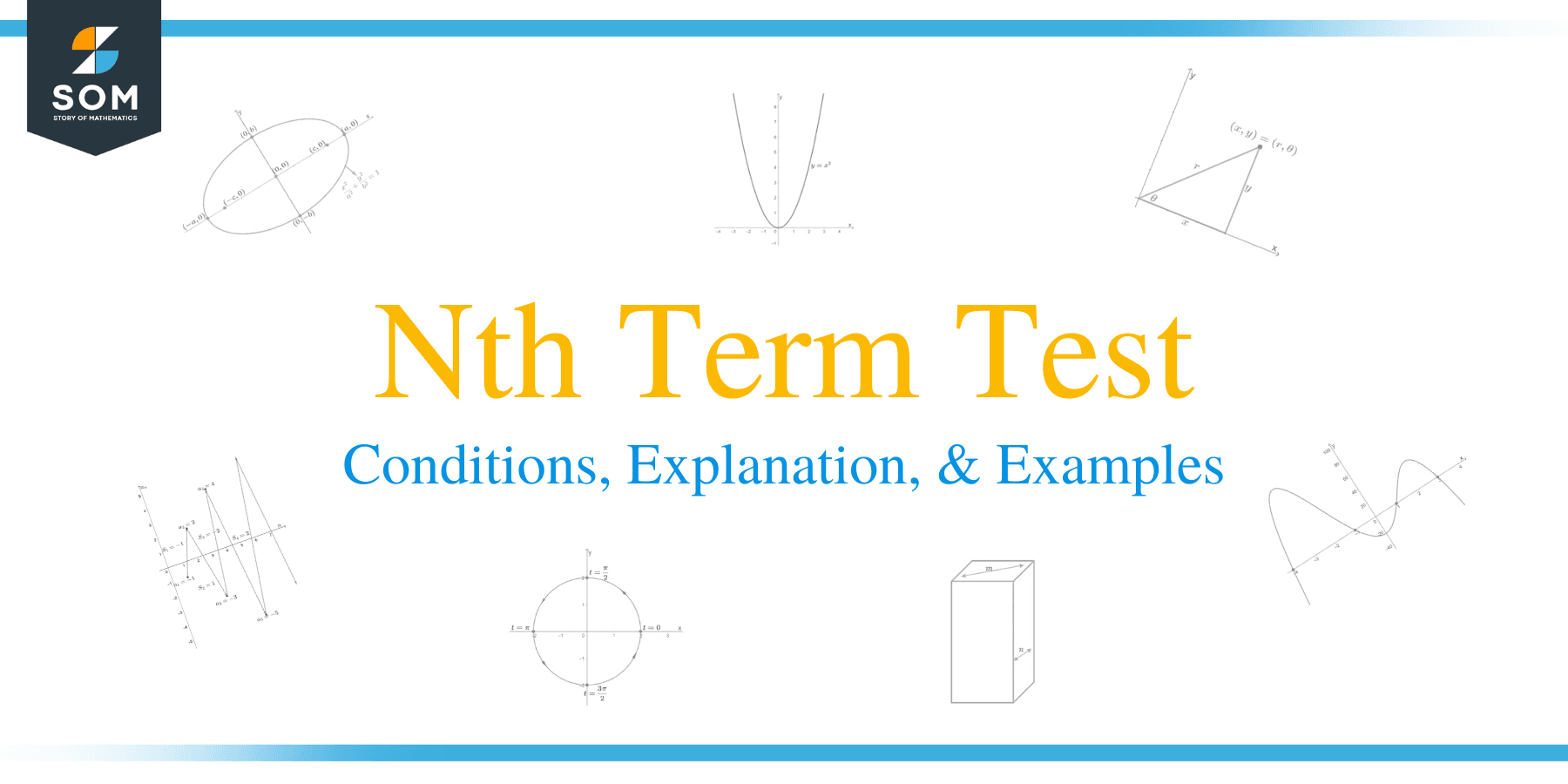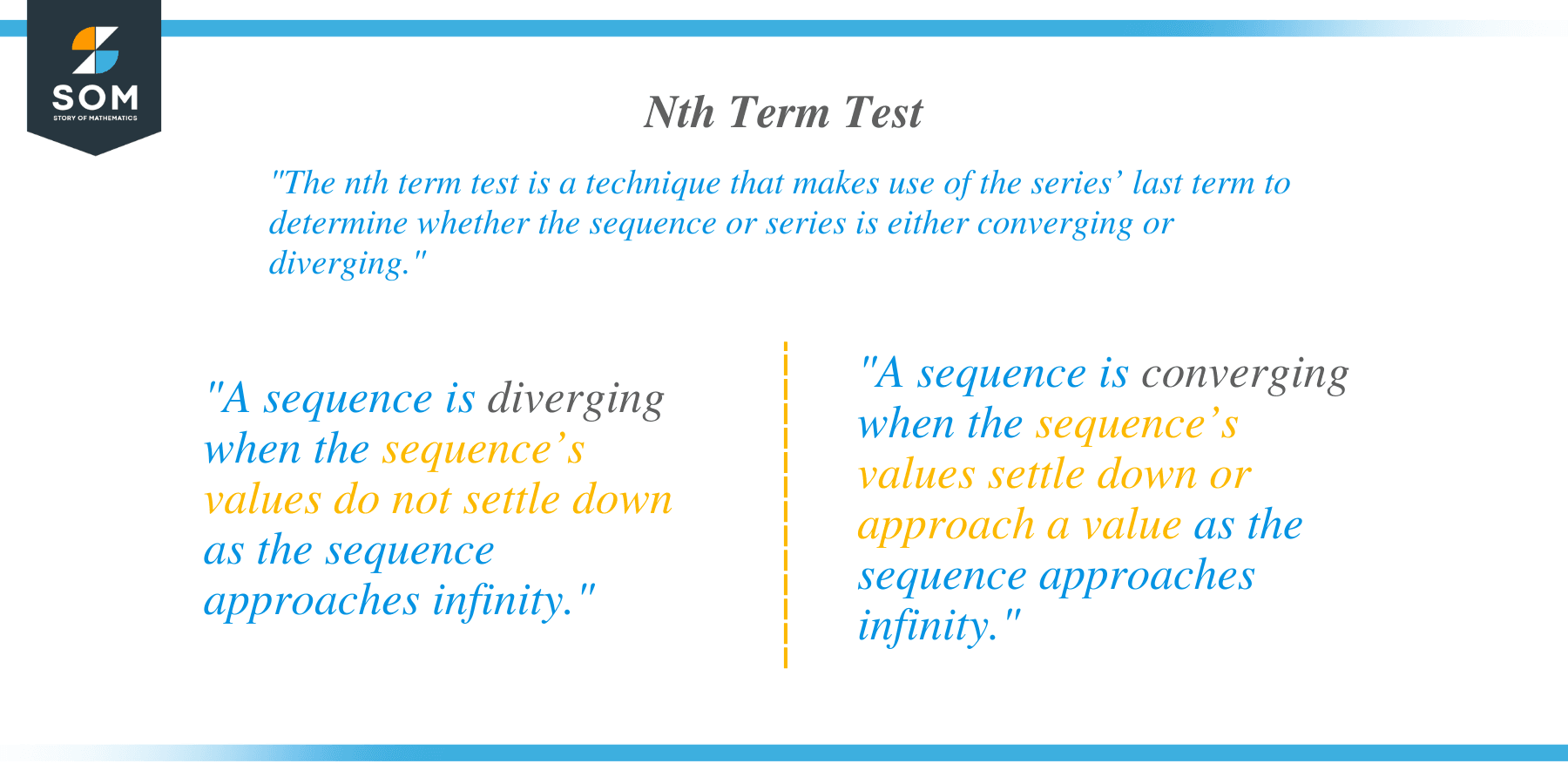- Home
- >
- Nth term test – Conditions, Explanation, and Examples
JUMP TO TOPIC
Nth Term Test – Conditions, Explanation, and Examples
 The nth term test is a helpful technique we can apply to predict how a sequence or a series behaves as the terms become larger. It is important for us to predict how sequences and series behave in higher mathematics and whether they converge or diverge.
The nth term test is a helpful technique we can apply to predict how a sequence or a series behaves as the terms become larger. It is important for us to predict how sequences and series behave in higher mathematics and whether they converge or diverge.
The nth term test is a technique that makes use of the series’ last term to determine whether the sequence or series is either converging or diverging.
This article will show how you can apply the nth term test on a given series or sequence. Make sure to review your knowledge on the following topics as we’ll need them in identifying whether a given series is divergent or convergent:
- Review your knowledge on applying the limit laws and evaluating limits.
- Refresh what you know about arithmetic series and sequences.
- Recall how we can find the sum of a geometric series and sequences.
For now, let’s go ahead and understand when the nth term test is most helpful and when it’s not. We’ll also review our knowledge on divergence and convergence, so let’s begin by understanding the nth term test’s definition!
What is the nth term test?
The nth term test helps us predict whether a given sequence or series is divergent or convergent. We make use of the sequence’s $n$th term to determine its nature, hence its name.
Before we dive right into the method itself, why don’t we go ahead and review what we know about diverging and converging sequences?
- A sequence is diverging when the sequence’s values do not settle down as the sequence approaches infinity.
- A sequence is said to be converging when the sequence’s values settle down or approach a value as the sequence approaches infinity.
The nth term test utilizes the limit of the sequence’s sum to predict whether the sequence diverges or converges.
- When using the nth term test, we’ll need to express the last term, $a_n$ in terms of $n$.
- We’ll have to find the value of the $a_n$’s limit as $n$ approaches infinity.
- The value of $\lim_{x\rightarrow \infty}a_n$ will determine whether the sequence or series converges or diverges.

The next sections will show us how to use the nth term test to determine whether a given series is divergent or not.
What is the nth term test for divergence?
According to the nth term test, a sequence is divergent when the sequence approaches a value other than zero as the sequence’s last term approaches infinity (term-wise).
Let’s say we have a sequence, $\{a_1, a_2, a_3, …, a_{n -1}, a_n\}$. The series formed by its sum can be expressed as $a_1 + a_2 + … + a_{n-1} + a_n$ or $\sum_{n=1}^{\infty} a_n$.
If $\lim_{x\rightarrow \infty}a_n$ is equal to a number other than zero, $\sum_{n=1}^{\infty} a_n$ is said to be divergent.
This makes sense since the values do not settle down for diverging series (either increasing or decreasing); the sequence at infinity must never be zero.
What is the nth term test for convergence?
Now, what happens when the nth term test returns a value of zero?
When $\lim_{x\rightarrow \infty}a_n = 0$ the sum of the series, $\sum_{n=1}^{\infty} a_n$, may or may not converge.
What does this mean for our sequence or series? We’ll have to use other tests such as a comparison test or alternating series test. But that’s for another article. We’ll limit our discussion to confirming that we may need to use another test for convergent tests.
When to use the nth term test?
There are different tests for divergence and convergence, but this test is the first one performed to tell us whether the series or sequence is divergent easily.
- Keep in mind that the nth term test helps us eliminate the rest of the tests by checking if the sequence is divergent first.
- Use the condition discussed above to conclude whether the sequence is divergent or if we need to use other tests to check if the sequence is convergent.
As mentioned in this article, knowing how to evaluate limits as functions and expressions approach infinity is essential when using the nth term test. Make sure to review your notes on limits or click the links we’ve provided in the earlier sections.
For now, that’s everything we need to learn about the nth term test. It’s time for us to check our knowledge and apply what we’ve learned about the nth term test. Try out the problems below and see if a given sequence diverges or not.
Example 1
Determine whether the sequence $3, 7, 11, 15, 19, 23, 27…$ diverges using the nth term test.
Solution
First, it helps if we can identify if the sequence is something we’ve learned in the past. Checking the difference between two consecutive terms, we have the following:
$7 – 3 = 4$ | $19 – 15 = 4$ |
$11 – 7 = 4$ | $23 – 19 = 4$ |
$15 – 11 = 4$ | $27 – 23 = 4$ |
We can see that the sequence’s terms share a common difference of $4$, so the sequence is, in fact, an arithmetic sequence.
We can express the last term, $a_n$, in terms of $n$ using the arithmetic sequence formula, $a_n = a_1 + (n-1)d$.
\begin{aligned} a_n &= a_1 + (n-1)d\\&=3 + (n – 1)4\\&=3 + 4n – 4\\&= 4n – 1\end{aligned}
Taking the limit of $a_n$ as it approaches infinity, we have the result below.
\begin{aligned} \lim_{n \rightarrow \infty }4n – 1 &= \infty\\&\neq 0\end{aligned}
We can see that the limit of the $n$th term, $a_n$ as $n$ approaches $\infty$ is not equal to $0$, so the sequence diverges.
Here’s a fun fact for you: arithmetic series and sequences, in general, are divergent. Why don’t you try to prove this on your own?
Example 2
Determine whether the series, $\sum_{n=1}^{\infty} \dfrac{n + 4}{5n – 1}$, is divergent.
Solution
Recall that the nth term test can help us determine whether the series is divergent by checking the limit of $a_n$ as $n \rightarrow \infty$.
We can find the limit of the expression by first multiplying the numerator and the denominator by $\dfrac{1}{n}$.
\begin{aligned}\lim_{n\rightarrow \infty}\dfrac{n + 4}{5n – 1} &= \lim_{n\rightarrow \infty}\dfrac{n + 4}{5n – 1} \cdot \dfrac{\dfrac{1}{n}}{\dfrac{1}{n}}\\&= \lim_{n\rightarrow \infty}\dfrac{1 + \dfrac{4}{n}}{5 – \dfrac{1}{n}}\end{aligned}
Recall that $\lim_{n\rightarrow \infty} \dfrac{k}{n} = 0$, where $k$ can be any real constant. Hence, we can evaluate the limit of the expression now.
\begin{aligned}\lim_{n\rightarrow \infty}\dfrac{1 + \dfrac{4}{n}}{5 – \dfrac{1}{n}} &= \dfrac{1 + 0}{5 – 0}\\&= \dfrac{1}{5}\end{aligned}
Since the limit of the nth term $a_n$ is equal to $\dfrac{1}{3}$ (and consequently, not equal to $0$), the series is not divergent.
Example 3
True or False? We can show that the series, $\sum_{n=1}^{\infty} \dfrac{3n^2 – 3}{4n^4 +2}$, is convergent through the nth term series.
Solution
We’ll apply a similar approach by first evaluating $\lim_{n \rightarrow \infty} \dfrac{3n^2 – 3}{4n^4 +2}$. We can begin by multiplying both the numerator and the denominator by $\dfrac{1}{n^2}$.
\begin{aligned}\lim_{n\rightarrow \infty}\dfrac{3n^2 – 3}{4n^4 +2} &= \lim_{n\rightarrow \infty}\dfrac{3n^2 – 3}{4n^4 +2} \cdot \dfrac{\dfrac{1}{n^2}}{\dfrac{1}{n^2}}\\&=\lim_{n\rightarrow \infty}\dfrac{3 – 3}{4n^2 +\dfrac{2}{n^2}}\end{aligned}
Simplify the expression further and use the fact that $\lim_{n\rightarrow \infty} \dfrac{2}{n^2} = 0$.
\begin{aligned}\lim_{n\rightarrow \infty}\dfrac{3 – 3}{4n^2 +\dfrac{2}{n^2}} &= \dfrac{0}{\infty + 0}\\&= \dfrac{0}{\infty}\\&=0\end{aligned}
Since the limit of the series’ nth term is $0$, the sequence is not divergent. But, this result can’t conclude for us whether the series is convergent. We’ll have to use advanced tests for that.
Hence, the statement is false, and we’ll need another test to confirm that the series is convergent.
Example 4
Use the fact that $f(n) = \dfrac{4n^4 – 5n^2 + 3n – 4}{n^5 – 6n^4 – 12n^2 + 2n + 6}$?
a. What is $\lim_{n \rightarrow \infty} f(n)$?
b. Using the result from 4a, what can you say about $\sum_{n=1}^{\infty} f(n)$?
Solution
To find the limit of the function as it approaches infinity, we can multiply the numerator and denominator of the expression by $\dfrac{1}{n^5}$.
\begin{aligned}\lim_{n \rightarrow \infty} f(x) &= \lim_{n \rightarrow \infty} \dfrac{4n^4 – 5n^2 + 3n – 4}{n^5 – 6n^4 – 12n^2 + 2n + 6} \cdot \dfrac{\dfrac{1}{n^5}}{\dfrac{1}{n^5}}\\&=\lim_{n \rightarrow \infty} \dfrac{\dfrac{4}{n} – \dfrac{5}{n^3} + \dfrac{3}{n^4} – \dfrac{4}{n^5}}{1 – \dfrac{6}{n} – \dfrac{12}{n^3} + \dfrac{2}{n^4} + \dfrac{6}{n^5}} \end{aligned}
Recall that the limit of rational expressions as their variable approach infinity is equal to zero. Use this fact to evaluate the limit of $f(x)$ as $n$ approaches $\infty$.
\begin{aligned}\lim_{n \rightarrow \infty} f(x) &=\dfrac{0 -0 + 0 – 0}{1 – 0 – 0 + 0 + 0}\\&= \dfrac{0}{1}\\&= 0 \end{aligned}
a. This means that the limit of $f(x)$ as it approaches infinity is equal to $0$.
The nth term test can confirm whether a series is divergent when the limit of the nth term is not equal to zero. But we’ve confirmed that $\lim_{n \rightarrow \infty} f(x) = 0$, so, $\sum_{n=1}^{\infty} f(x)$ is not divergent.
Other than that, we can’t conclude whether the sequence is convergent or not. We’ll have to use other tests to confirm that.
b. For now, what we can conclude is that $\sum_{n=1}^{\infty} f(x)$ will not be divergent.

